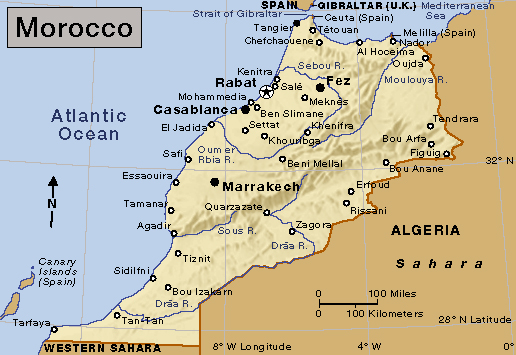Fez, also spelled Fès (pop. 1,112,162), is a city in northern Morocco, a country in the northwestern corner of Africa. Fez is an important cultural and religious center of Morocco and one of its traditional capitals. Fez is famous for its religious sites, its suqs (markets), and the many winding streets of its medina (old Arab quarter).

Fez lies along the banks of the Fez River (also called the Wadi Fès) near the foothills of the Atlas Mountains. The city is some 105 miles (170 kilometers) east of Rabat, the Moroccan capital. Fez is the capital of the region of Fès-Boulemane. Regions are the main administrative units of Morocco. Fez is a bustling commercial center noted for its silk, woolen, and leather goods. Among the streets of modern Fez, buses, cars, and trucks are common means of transport. The alleyways of the sprawling medina—too narrow for automobiles—carry only foot traffic. An airport, railroads, and highways connect Fez with a number of other cities. Fez is divided into three distinct areas: Fès el-Bali (Old Fez), Fès el-Jedid (New Fez), and the Ville Nouvelle (New City).
Arab ruler Idrīs I, of the Idrīsid dynasty (series of rulers from the same family), founded Fez on the east bank of the Fez River in 789. Idrīs II, his son, built a separate settlement on the west bank of the river in 808. The tomb of Idrīs II is part of a noted Muslim shrine in the city. One of the world’s oldest universities, al-Qarawīyīn University, was founded in Fez in 859. In the 1000’s, the settlements joined to form one city, an area now called Fès el-Bali. It thrived as a center of commerce and learning even after rulers from Morocco’s Almoravid dynasty made Marrakech their capital in the late 1000’s. Fès el-Bali has changed little over time, and makes up a large part of the city’s medina. Suqs, madrasahs (Islamic schools), fountains, and mosques dominate the narrow passages of Fès el-Bali, as do the smells of one of the world’s oldest tanneries.
In the mid-1200’s, Sultan Abū Yūsuf Ya’qūb of the Marīnid dynasty began an expansion of the city—Fès el-Jedid—nearby. Fès el-Jedid served as the seat of government until the early 1500’s. Fès el-Jedid today makes up the rest of the medina. It contains the Marīnid royal palace and Great Mosque, fortifications, and many residential buildings.
Fez declined in the 1600’s, when the nearby city of Meknès gained prominence. But Fez again served as a capital from the early 1700’s until the French occupation of Morocco in 1912. Much of Fez’s Ville Nouvelle was constructed during the French occupation, which ended in 1956. The Ville Nouvelle has wide avenues and modern residential and industrial buildings. A vast majority of Fez’s population works and lives in the Ville Nouvelle.
The Medina of Fez became a World Heritage Site in 1981. Such sites are designated places of unique cultural or natural importance by the United Nations Educational, Scientific and Cultural Organization (UNESCO).
Fez gave its name to a kind of tall, red, brimless cap with a colored tassel of silk or wool. The hat—sometimes called a tarboosh—was once widely worn throughout North Africa.
